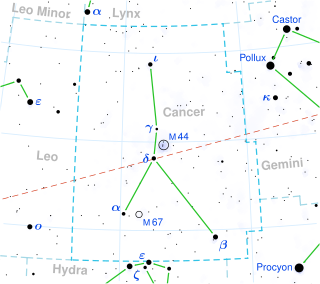 An ultraviolet band light curve showing several flares on EI Cancri, adapted from Pettersen (1985) [1] | |
| Observation data Epoch J2000 Equinox J2000 | |
|---|---|
| Constellation | Cancer |
| Right ascension | 08h 58m 15.194s [2] |
| Declination | +19° 45′ 47.08″ [2] |
| Apparent magnitude (V) | 13.720 [3] |
| Characteristics | |
| Spectral type | M8Ve+M7V [4] [5] |
| Astrometry | |
| G 9-38 A | |
| Radial velocity (Rv) | 13 ± 5 [6] km/s |
| Proper motion (μ) | RA: −767.060±0.122 [7] mas/yr Dec.: −100.176±0.083 [7] mas/yr |
| Parallax (π) | 194.1443±0.1228 mas [7] |
| Distance | 16.80 ± 0.01 ly (5.151 ± 0.003 pc) |
| G 9-38 B | |
| Proper motion (μ) | RA: −937.133±0.190 [8] mas/yr Dec.: −34.559±0.138 [8] mas/yr |
| Parallax (π) | 196.2619 ± 0.1976 mas [8] |
| Distance | 16.62 ± 0.02 ly (5.095 ± 0.005 pc) |
| Orbit | |
| Primary | G 9-38A |
| Companion | G 9-38B |
| Period (P) | 360 yr |
| Semi-major axis (a) | 33 AU |
| Details [9] [10] | |
| G 9-38A | |
| Mass | 0.127±0.043 [11] M☉ |
| Radius | 0.136±0.020 [11] R☉ |
| Luminosity (bolometric) | 0.000965 L☉ |
| Temperature | 2896±18 K |
| Metallicity [Fe/H] | +0.08 [11] dex |
| G 9-38B | |
| Mass | 0.111±0.045 [11] M☉ |
| Radius | 0.119±0.021 [11] R☉ |
| Luminosity (bolometric) | 0.000992 L☉ |
| Metallicity [Fe/H] | +0.14 [11] dex |
| Other designations | |
| EI Cnc, GJ 1116, WDS J08582+1945AB, G 9-38, G 47-14, G 41-11, LP 426-40, LTT 12343, PLX 2144.03, GSC 01397-01138, 2MASS J08581519+1945470 | |
| A: Gaia DR2 660597997696173440, LHS 2076 [4] , NLTT 20638 [4] | |
| B: Gaia DR2 660597997697274752, LHS 2077 [5] , NLTT 20637 [5] | |
| Database references | |
| SIMBAD | The system |
| A | |
| B | |
Location of G 9-38 in the constellation Cancer | |
G 9-38, also known as EI Cancri and GJ 1116, is a binary star system consisting of two M-type stars. [12] Located at a distance of 16.7 light-years, it is among the nearest star systems. [13]
In 1985, Bjørn Ragnvald Pettersen announced his discovery that the star shows very high stellar flare activity, with an average of five flares per hour. [1] It was given its variable star designation, EI Cancri, in 1987. [14]
In 2015, the search for third star in the system has yielded inconclusive results. [15]
